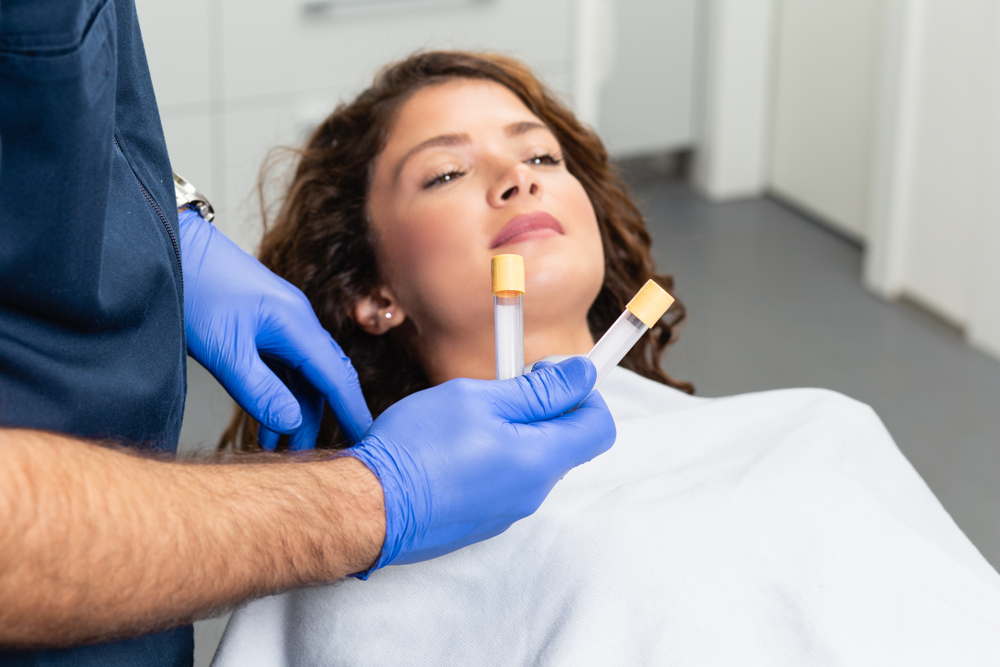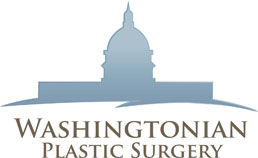
For women and men in Chevy Chase, Maryland and McLean, Virginia, looking for a natural, nonsurgical, and effective way to rejuvenate skin and hair, platelet rich plasma (PRP) may offer an ideal solution.
PRP is a non-surgical therapy that is often combined with other cosmetic treatments. It involves harvesting growth factors from the patient’s own blood to promote cellular regeneration and regrowth of hair, collagen, elastin, and blood vessels.
Continue reading to learn all about platelet rich plasma, including what Maryland and Virginia area patients can expect from treatment and the therapeutic benefits of PRP hair restoration, dermal fillers with PRP, and microneedling PRP.
What is Platelet Rich Plasma?
Platelet rich plasma is a blood component that is chock full of growth factors and has enormous healing capabilities.
Accordingly, PRP has been used for years in sports medicine to treat arthritis, joint pain, and tendon repair as well as accelerate recovery from injuries. It has also proven to be extremely useful in dentistry for the purpose of bone grafting.
More recently, platelet rich plasma has become an increasingly popular therapy for cosmetic and plastic surgery procedures. Not only can PRP enhance treatment outcomes, it also has no side effects or chance of rejection.
What Are the Benefits of PRP?
One of the key benefits of PRP is that it is a naturally-occurring substance derived from the patient’s own blood.
As a result, there is little to no risk of allergic reaction or incompatibility when used with hair restoration, dermal fillers, microneedling, or other anti-aging treatments.
Additionally, PRP aids in regenerative and reparative processes by triggering the body’s innate healing capabilities. This provides long-lasting and natural-looking results for a wide-range of cosmetic applications.
What’s more, PRP treatment is nonsurgical, quick, relatively painless, and requires minimal downtime. Best of all, it produces visible results that can improve the way patients look and feel.
PRP Hair Restoration
Hair loss and thinning are common issues that affect millions of men and women. And while topical creams and hair transplant surgery are viable treatment options, they each present with certain challenges.
Topical hair loss solutions can be messy, ineffective, time-consuming, and produce unwanted side effects. Hair transplant surgery is a more invasive procedure that carries additional risks, cost, and recovery.
For these reasons, PRP hair restoration offers a safe, effective, and non-surgical alternative with better and faster results.
How Does PRP Hair Restoration Work?
During a PRP hair restoration treatment, a sample of blood is drawn from the patient and placed in a machine called a centrifuge. The centrifuge spins the blood in order to separate platelet rich plasma for other parts of the blood.
PRP is then collected in a syringe and injected into the scalp to address areas of hair loss and thinning. This allows PRP and its numerous growth factors to stimulate the proliferation of reparative cells and prolong the active phase in the hair growth cycle.
PRP Hair Restoration Results
Following PRP hair restoration, patients will be pleased to note reduced shedding. In some cases, shedding may cease all together.
The effects of PRP can also reverse the miniaturization process, producing thicker and fuller hair growth.
Additionally, this hair loss treatment has the ability to increase the chance of overall hair growth and slow down hair loss in the future.
To achieve optimal outcomes, most patients need a series of treatments, with occasional maintenance sessions.
Dermal Fillers with PRP
Dermal fillers are injectable products designed to restore volume, smooth wrinkles, fill hollows, and enhance facial features and contours.
They are also well-equipped to counteract other signs of aging such as vertical lip lines, deepening folds, and visible bones and tendons in hands.
Similarly, PRP is a potent anti-aging and rejuvenation tool that stimulates collagen growth and angiogenesis for correction of fine lines, wrinkles, scarring, skin laxity, and stretch marks.
When you undergo treatment with a dermal filler and PRP simultaneously, your skin receives double the healing action.
That’s because filler offers immediate volumizing and hydrating effects, while PRP promotes cellular renewal and collagenesis. This synergy maximizes anti-aging benefits and produces smoother, firmer, brighter, tighter, and more radiant skin.
Platelet rich plasma is extremely versatile and can enhance the effects of a variety of injectables including: Dysport, Botox, Juvéderm, Juvéderm Voluma, Juvéderm Volbella, Juvéderm Ultra, Juvéderm Ultra Plus, Restylane, Restylane Silk, Restylane Lyft, Restylane Defyne, Restylane Refyne, Sculptra, Radiesse, and Belotero.
Microneedling with PRP
On its own, microneedling – also known as collagen induction therapy – provides powerful healing and reparative capabilities.
It uses an automated pen and a single-use tip of ultra-fine needles to create tiny punctures in the skin. These micro-injuries trigger a wound healing response and stimulate the production of collagen, elastin, and hyaluronic acid.
As a result, damaged tissue undergoes intense remodeling and heals itself from the inside out.
What Conditions Can Microneedling with PRP Treat?
Platelet rich plasma is frequently combined with microneedling to enhance efficacy and produce ultimate skin revitalization.
The treatment is conducted in the comfort of our office and can address virtually any skin concern, including:
- Photodamage
- Hyperpigmentation
- Sun spots
- Age spots
- Fine lines
- Wrinkles
- Acne scars
- Stretch marks
- Uneven tone
- Rough texture
- Skin laxity
What Can Patients Expect from Microneedling with PRP?
Prior to microneedling with PRP, skin is cleansed and treated with a topical anesthetic. It takes approximately 30 minutes for the numbing cream to take effect.
A sample of blood is taken from the patient and is no different than any other type of blood draw. The centrifuge then spins the blood to isolate platelet rich plasma (PRP).
Next, an automated pen with surgical-grade needles gently glides over skin, creating small holes. Needle length and depth of penetration can be modified depending on the treatment area and patient goals. Most professional microneedling devices contain needles that range from 0.5 mm to 3 mm.
Finally, platelet rich plasma is massaged into skin and readily absorbed by the newly-created microchannels.
At the end of the treatment, a serum or balm may be applied to the skin to minimize inflammation. Skin may appear slightly red or swollen, but these side effects quickly resolve on their own without issue.
Is There Any Downtime?
Post-procedure, patients are free to return home and go about their day as they normally would.
With that being said, you should take several precautions after microneedling with PRP. To start, it’s important to avoid alcohol-based products and exfoliants, which can further irritate skin and interfere with healing.
Patients are also advised to shield their skin from sun exposure and apply a daily broad-spectrum sunscreen with at least a 30 SPF.
You should also forgo strenuous physical activities, that may produce excessive sweating and hot temperatures, for at least 72 hours. That’s because perspiration can exacerbate irritation and make you more prone to swelling and/or bruising.
Microneedling with PRP Results
In order to achieve optimal skin rejuvenation and enhancement, most patients require a series of microneedling with PRP sessions, spaced four-to-six weeks apart. Results occur gradually and cumulatively.
Within weeks, you’ll see visible improvement in tone, texture, and vibrancy. As new collagen and elastin develop, skin will appear smoother, refreshed, and more youthful.
InTerested in Platelet Rich Plasma (PRP) Treatments?
If you are interested in PRP hair restoration, dermal fillers with PRP, or microneedling with PRP, please call our office today to schedule a comprehensive consultation with board-certified plastic surgeon Dr. Navin Singh.
How Ultherapy Is Revolutionizing Non-Surgical Facelifts
Discover the Non-Surgical Way to Lift and Tighten Your Skin: Ultherapy Aging is inevitable, but looking your age is optional. While we can’t turn back [...]
Unlocking the Secrets to a More Sculpted Face: What Causes Facial Fat & How to Reduce It
Your face is the first thing people notice about you—it shapes your overall appearance and can influence how youthful and defined you look. But for [...]
Everything You Need to Know About Enhancing Your Lips and the Area Around Them
Your lips and the skin around your mouth play a starring role in how you look and express yourself. They frame your smile, highlight your [...]


